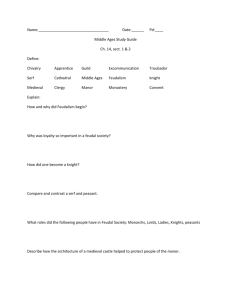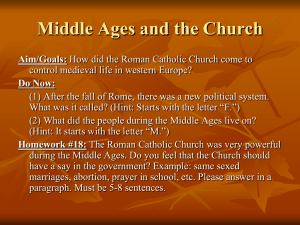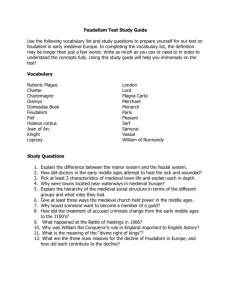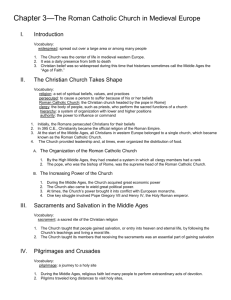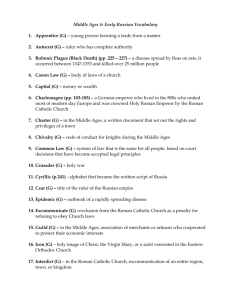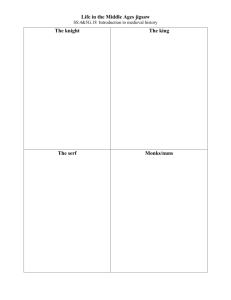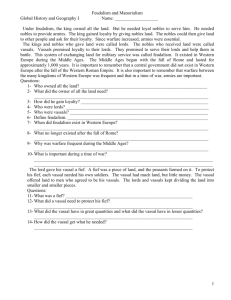Medieval Europe - The Manor, The Lord, and The Church
advertisement
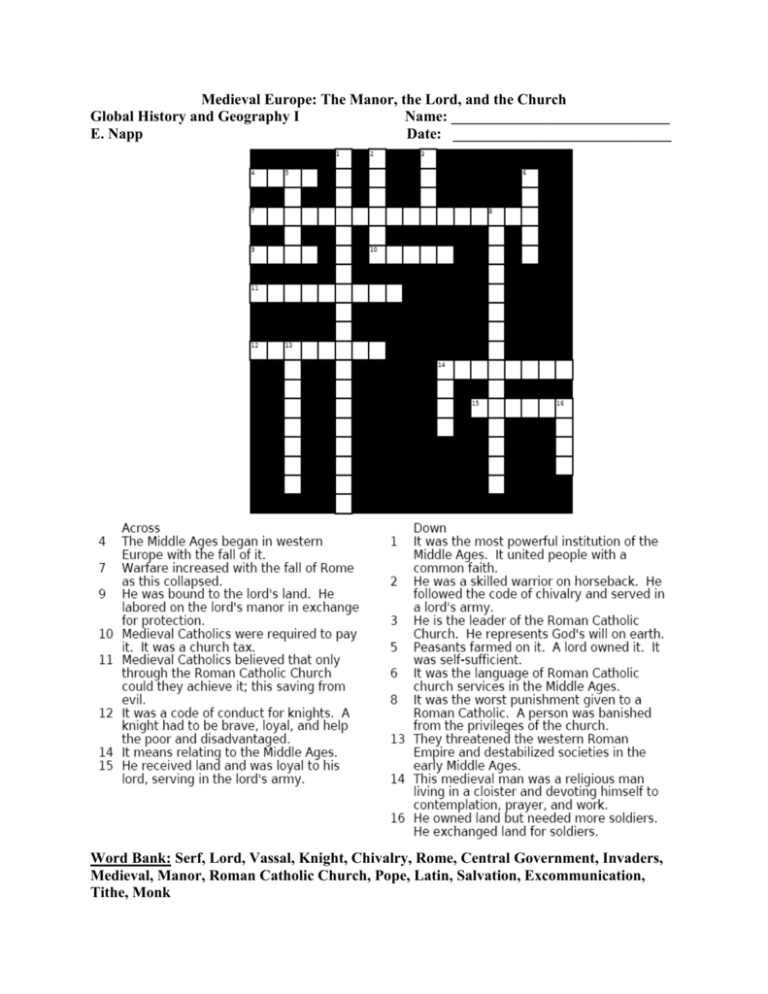
Medieval Europe: The Manor, the Lord, and the Church Global History and Geography I Name: _____________________________ E. Napp Date: _____________________________ Word Bank: Serf, Lord, Vassal, Knight, Chivalry, Rome, Central Government, Invaders, Medieval, Manor, Roman Catholic Church, Pope, Latin, Salvation, Excommunication, Tithe, Monk 1. What was the most important force in providing unity and stability throughout western Europe during the Middle Ages? (1) church (3) inquisition (2) nobility (4) military 2. In western Europe, feudalism developed after the (1) Roman Empire collapsed (2) Renaissance began (3) city of Constantinople fell (4) Mongols invaded 3. The term feudalism is best defined as a (1) holy war between Christians and Muslims (2) process in which goods are traded for other goods (3) division of political power between three separate branches (4) system in which land is exchanged for military service and loyalty 4. Which is a characteristic of a feudal society? (1) rapid social change (2) high literacy rate (3) industrial-based economy (4) rigid class structure 5. In European feudal society, an individual’s social status was generally determined by (1) birth (2) education and training (3) individual abilities (4) marriage 6. Which economic system existed in Europe during the early Middle Ages? (1) free market (2) socialism (3) manorialism (4) command 7. The growth of feudalism in Europe during the Middle Ages was primarily caused by the (1) rivalry between the colonial empires (2) suppression of internationalism (3) decline of the Roman Catholic Church (4) collapse of a strong central government 8. The Roman Catholic Church during the Middle Ages in Europe can best be described as a church that (1) favored separation from secular governments (2) avoided involvement in social and educational matters (3) was a strong force that divided many people (4) was a stabilizing influence during a period of weak central governments 9. A major goal of the Christian Church during the Crusades (1096–1291) was to (1) establish Christianity in western Europe (2) capture the Holy Land from Islamic rulers (3) unite warring Arab peoples (4) strengthen English dominance in the Arab world 10. There are no precise, incontrovertible dates to define the beginning or end of the Middle Ages. However, many scholars agree that the start of the medieval era is marked by a very significant development that took place in the fifth century. What is that development? (1) The Black Death (2) The Fall of Rome (3) The Renaissance (4) The Scientific Revolution Adapted from msnu.edu “The Roman Catholic Church was the single, largest unifying structure in medieval Europe. It touched everyone's life, no matter what their rank or class or where they lived. With the exception of a small number of Jews, everyone in Europe was a Christian during the Middle Ages from the richest king down to the lowest serf. From the moment of its baptism a few days after birth, a child entered into a life of service to God and God's Church. As a child grew, it would be taught basic prayers, would go to church every week barring illness, and would learn of its responsibilities to the Church. Every person was required to live by the Church's laws and to pay heavy taxes to support the Church. In return for this, they were shown the way to everlasting life and happiness after lives that were often short and hard. In addition to collecting taxes, the Church also accepted gifts of all kinds from individuals who wanted special favors or wanted to be certain of a place in heaven. These gifts included land, flocks, crops, and even serfs. This allowed the Church to become very powerful, and it often used this power to influence kings to do as it wanted.” Questions: 1: What was the single, largest unifying structure in medieval Europe? ______________________________________________________________________________ 2: Who was touched by the Roman Catholic Church in the Middle Ages? ______________________________________________________________________________ 3: What did the Church expect children to do? ______________________________________________________________________________ 4: What did the Church give in return for the taxes people paid? ______________________________________________________________________________ 5: Why did individuals give the Church gifts? ______________________________________________________________________________ 6: Provide examples of gifts. ______________________________________________________________________________ 7: So, why was the Church so wealthy and powerful during the Middle Ages? ______________________________________________________________________________ ______________________________________________________________________________ “Because religion was so important during the Middle Ages, many people devoted their whole lives to being closer to God and doing the Church's work. Sometimes, parents promised their children to this religious life in order to fulfill a promise to God and to ensure their children were never homeless or without food. These people became monks (if they were men) or nuns (if they were women) and lived apart from the rest of the people in special communities called monasteries and nunneries. Monks and nuns promised to always remain single, to be obedient to their superiors and to live a life of prayer. They ate simple food, dressed in simple clothes (called habits) and spent their days in silence, praying or working. They also attended many church services. There were seven main church services each day, the first at dawn and the last in the middle of the night.” 8: Why did many people devote themselves to God? ______________________________________________________________________________ 9: Why did parents sometimes promise their children to the religious life? ______________________________________________________________________________ 10: Who were monks and nuns? ______________________________________________________________________________ 11: What did monks and nuns promise? ______________________________________________________________________________ 12: Describe a day in the life of a monk or nun. ______________________________________________________________________________ Adapted from historyonthenet.com Explain the diagram below: _______________________ _______________________ _______________________ “St. Benedict, founder of the Benedictine monks believed that the cure of the sick was one of the most important duties of monks. During the dark ages, monasteries were the only hospitals in Europe. Patients were cared for in the hospitals until they recovered or died. Their fate was God’s will. Prayer and/or pilgrimages to holy shrines were considered the best methods of affecting a cure.” Questions: 1: Who was Saint Benedict? ________________________________________________ 2: What did Saint Benedict believe was one of the most important duties of a monk? ________________________________________________ 3: What were the only hospitals in Europe during the Middle Ages? ________________________________________________ 4: According to the monks, what determined if a person recovered? ________________________________________________ Define the following terms: Lord: _____________________________________ _____________________________________ Vassal: _____________________________________ _____________________________________ Serf: _____________________________________ _____________________________________ How did the status of a serf differ from the status of a free man? How did the status of a serf differ from a slave? _________________________________ _________________________________ How does medieval society differ from modern society? _____________________________________ _____________________________________ _____________________________________ _____________________________________ _____________________________________ _____________________________________


